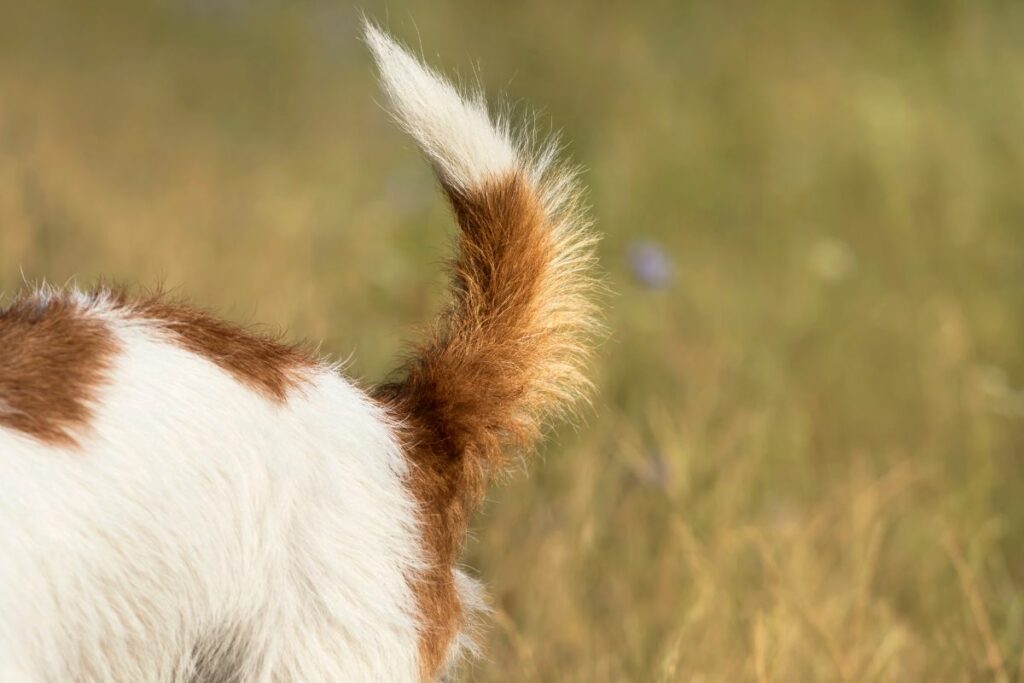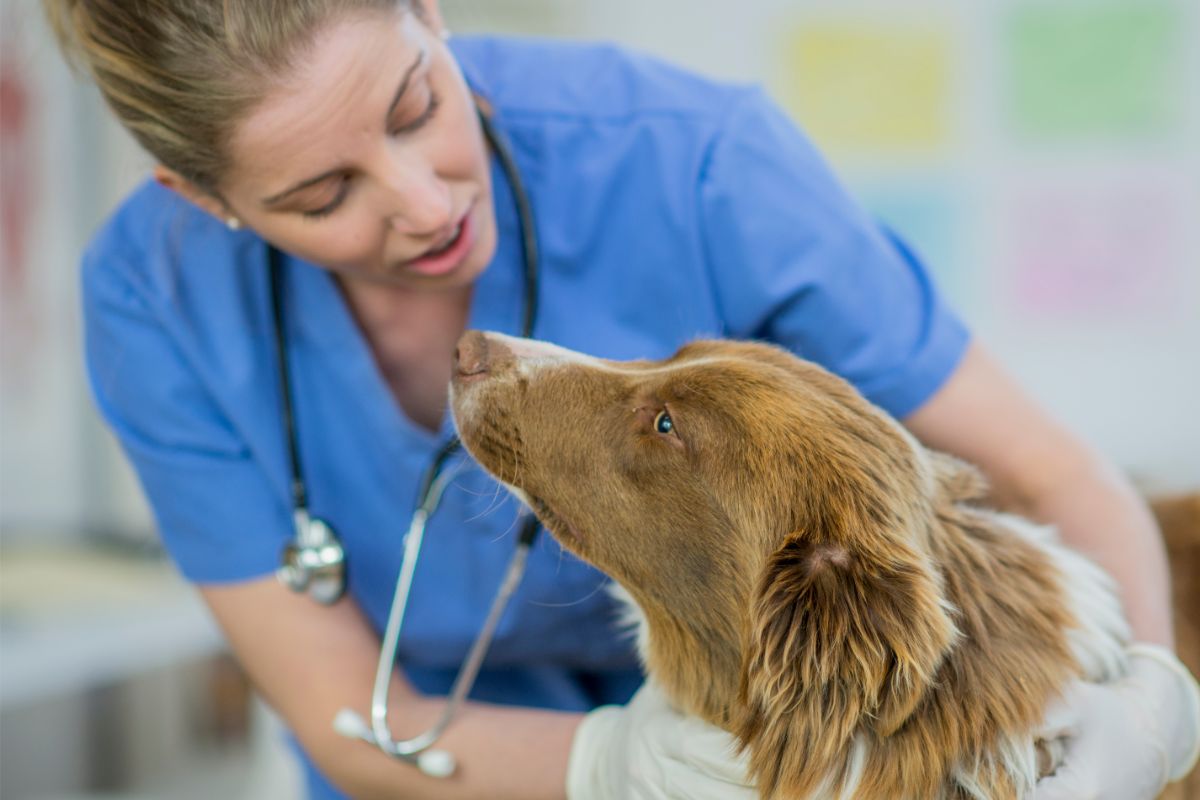If you’ve ever witnessed your furry, four-legged friend incessantly biting the base of their tail, you’re not alone.
It’s a perplexing situation that many dog owners find themselves in and, more often than not, is responsible for creating concern, confusion, and worry.

In this comprehensive guide to why dogs bite the base of their tail, we’ll explore the possible reasons behind this behavior and take a look at some of the potential causes and remedies and when it’s time to consult a veterinarian.
Why Is My Dog Is Biting The Base Of Its Tail?
As dedicated dog owners, we’ve all experienced moments of bewilderment when our beloved canine companions exhibit seemingly inexplicable behaviors like focusing on nibbling the area around the base of their tails.
To truly understand this behavior, we need to explore the most common reasons that could contribute to this peculiar habit.
Understanding the nuances of your dog’s behavior often requires careful observation, so it’s important to consider any and all recent changes in their environment, routine, or interactions with other pets or people because, as we all know, dogs often communicate with us through their actions, and tail-biting may be a signal of underlying stress or discomfort.
Flea-Free Doesn’t Mean It’s Flealess
Contrary to popular belief, a lack of visible fleas doesn’t necessarily guarantee a flea-free dog as infestations can be elusive, and if your dog is allergic to flea saliva, that allergy could be a reason for the relentless itching even with a minimal flea presence.
We found that thoroughly examining your dog’s fur with a fine-toothed comb can reveal the subtle presence of fleas or their residue, and while searching for fleas, always pay attention to “flea dirt,” the small black specks that indicate that your dog might have some unwelcome visitors.
Even if you don’t see adult fleas, the presence of their detritus is a definitive indication that it’s time to get your canine friend treated for the fleas that are probably there, even though you can’t see them.
It’s An Allergy Thing
Like us, our canine companions can have any number of different allergies, and whether it’s a reaction to specific ingredients in their food or environmental allergens, they can all lead to skin irritation and problems.
Dogs are unable to express their discomfort verbally and can’t tell us what’s wrong, so resort to scratching and biting themselves and often targeting the base of their tail.
Addressing and identifying any possible underlying allergen is crucial to possibly resolving this issue.
Food allergies are not uncommon in dogs, and they can manifest in various ways, so speak to your veterinarian about the possibility of creating a hypoallergenic diet for your pal or allergy testing them to pinpoint the allergen causing the discomfort.
Anal Gland Issues
As uncomfortable or awkward as it can be to talk about this subject, one of the potential causes of tail biting or pulling out hair from the tail is a possible anal gland problem, which can manifest itself as tail-biting as your dog attempts to alleviate his or her discomfort.
If their anal glands have become impacted or infected, the resulting irritation can drive dogs to bite and nibble at their tail, and a prompt veterinary examination can help to diagnose and treat any possible anal gland issues.
These problems are more prevalent in some breeds than in others, and regular check-ups with your vet can help to identify and treat them.

Stress And Anxiety
Just like humans, dogs can suffer from stress and anxiety, and tail-biting may be an outward expression of the inner turmoil that they’re feeling.
Dogs are incredibly sensitive to changes in their environment and routine and the introduction of new people, all of which can act as triggers for canine stress.
Providing a stable and comforting environment, coupled with positive reinforcement, can alleviate stress-induced behavior, and positive reinforcement, with treats and praise, can help reassure your dog and reduce their stress levels.
However, in some cases, professional training or consultation with a veterinary behaviorist may be necessary to address underlying anxiety issues.
Skin Infections
Skin infections can fester and take hold under your dog’s fur and can cause intense itching and make your dog nibble and bite at their tail, and bacterial or fungal infections can easily go unnoticed until they become a source of discomfort for your canine companion.
Regular grooming, including thorough skin checks, can help catch these infections early, and when you’re examining your dog’s skin, look for redness, inflammation, or unusual odors, as these are often the telltale signs of skin infection and the treatment for these infections is usually topical or oral medications which need to be prescribed by your veterinarian.
Dry Skin
Dry skin can also lead to irritation, which can cause excessive scratching and biting, and factors such as changes in the weather, inadequate grooming, or an improper diet can contribute to dry skin in dogs.
Adjusting your dog’s diet to include essential fatty acids and providing proper grooming can significantly improve most dry skin conditions.
Regular brushing can be a big help in distributing the natural oils that are present in your dog’s fur, and daily grooming can help to spread them and improve your dog’s overall skin health.
Neurological Issues
In some instances, tail-biting behavior can be caused by neurological issues.
Nerve damage or other neurological conditions can cause unusual sensations all over your dog’s body and lead to them seeking relief through biting and identifying and addressing such issues often requires the expertise of a veterinarian specializing in neurology.
Neurological issues can manifest themselves in various ways, and a thorough examination and comprehensive testing may be necessary for diagnosis if you’ve exhausted all of your other options.
Treatment will depend on the specific condition your dog is suffering from.
Other Parasites
While fleas are the most notorious, other parasites, such as mites or ticks, can also trigger discomfort, and conducting a thorough inspection of your dog’s coat and consulting your vet is the best way to rule out these often-missed culprits.
Ticks and mites can cause itching, redness, and discomfort, all of which can lead to tail-biting behavior.
The usage of a broad-spectrum parasite preventive can help protect your dog from these external parasites, and the prompt removal of any ticks and the appropriate treatment for mites are essential for your dog’s overall well-being.
Injury Alert
Dogs are resilient creatures, and they’re adept at hiding their pain, but a hidden injury might be the reason behind persistent tail-biting, so checking for signs of wounds or bruises and observing your dog’s gait for possible indications of any pain is crucial.
Inspect your dog’s tail and surrounding area for any cuts, abrasions, or foreign objects that might be causing them discomfort.
Swelling, redness, or changes in behavior may indicate an underlying injury, and if you do find one, speak to your vet as soon as possible in order to assess and address the issue effectively.
Canine OCD
Believe it or not, dogs can suffer from obsessive-compulsive disorder (OCD), and tail-chasing or biting can be symptomatic of the condition, and a combination of behavioral therapy and, in some cases, medication can help manage OCD-related tail-biting.
OCD behaviors in dogs often require a multifaceted approach to treatment.
A veterinary behaviorist can assess your dog’s specific compulsive behaviors and develop a tailored plan that may include behavior modification, environmental enrichment, and, in some cases, prescription medications to address their underlying anxiety and compulsions.
Hormonal Havoc
Hormonal imbalances, especially in unneutered male dogs or females in heat, can lead to heightened irritability and a tendency to bite or chew at the tail, and spaying or neutering your furry friend can help to regulate hormonal fluctuations and curb their tail-biting behavior.
Boredom Biting
Our canine companions thrive on mental and physical stimulation, and boredom can lead to destructive behavior, including tail-biting, which underscores the importance of ensuring your dog receives adequate exercise, playtime, and mental stimulation in order to ward off boredom-induced tail-biting.
By enriching your dog’s environment with interactive toys, puzzle feeders, and regular playtime, and taking advantage of activities that tap into your dog’s natural instincts, such as scent games or agility exercises, you can help to prevent them from becoming bored and put an end to their tail biting.
When To Seek Professional Help
If your dog’s tail-biting persists or worsens despite your efforts, it’s time to seek professional help.
Your veterinarian can conduct a thorough examination, perform diagnostic tests, and create a tailored treatment plan based on the specific underlying cause of the behavior.
Final Thoughts
When faced with the perplexing scenario of a dog biting the base of its tail without any visible fleas, a methodical and patient approach is key.
By taking into consideration all of the factors that we’ve discussed, we can better understand our furry friends’ unique needs and provide the care and attention they deserve.
It’s always important to remember that when all else has failed, your veterinarian is your best ally in ensuring the health and happiness of your beloved canine companion.
- Help! My Dog Is Biting The Base Of Its Tail But Has No Fleas - October 18, 2023
- Similar Breeds: A Look At 10 Dogs Like Bernese Mountain Dogs - October 16, 2023
- Grooming Guide: How To Groom Bernese Mountain Dogs - October 13, 2023










